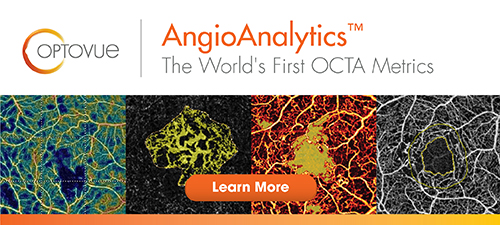Systemic Safety in Ranibizumab-treated Subjects with nAMD
Combining En Face OCTA with Structural OCT & Blood Flow Analysis to Detect CNV in PEDs
OCTA in Eyes with Indeterminate Choroidal Neovascularization
Atrophy in nAMD Using OCTA to Assess Neovascularization Characteristics in Early PDR Retinal Vessel Geometric Characteristics and DR Incidence & Progression Vitreomacular Interface Abnormalities in DME & Implications for Anti-VEGF Therapy Investigators aimed to determine whether the presence of vitreomacular interface abnormalities in individuals with diabetic macular edema would modify the response to ranibizumab. They reviewed medical records and spectral-domain optical coherence tomography scans of consecutive cases with center-involving DME that received ranibizumab therapy between December 2013 and March 2014, at the Belfast Health and Social Care Trust. They identified individuals through an electronic database and recorded: • demographics; • systemic baseline characteristics; • history of previous ocular surgery/laser; • best-corrected visual acuity; • central retinal thickness; • stage of retinopathy at presentation; • and BCVA, CRT and presence/absence of fluid at the last follow-up. A masked investigator reviewed and graded OCT scans for the presence/absence of VMIAs at baseline and follow-up, and for changes in the posterior hyaloid face during follow-up. A total of 146 eyes (100 people; mean age: 63.5 years) followed for a mean of nine months (range: two to 14 months) were included. In eyes with and without VMIAs, and in eyes without VMIAs with better levels of vision, higher frequency of macular laser and lower frequency of PRP, statistically significant differences were observed at baseline in: • BCVA (p=0.007); • previous macular laser and panretinal photocoagulation (p=0.006); and • previous cataract surgery (p=0.01). Multivariable regression analyses didn’t disclose statistically significant associations between VMIAs at baseline, changes in the posterior hyaloid face during follow-up, or in functional/anatomical outcomes following treatment. Researchers determined that VMIAs were associated with worse presenting vision in individuals with DME. Furthermore, they added, that VMIAs or changes in the posterior hyaloid face during follow-up didn’t modify responses to ranibizumab. SOURCE: Mikhail M, Stewart S, Seow F, et al. Vitreomacular interface abnormalities in patients with diabetic macular oedema and their implications on the response to anti-VEGF therapy. Graefes Arch Clin Exp Ophthalmol 2018; May 19. [Epub ahead of print]. Disorganization of Retinal Inner Layers with Ischemic Index & VA in CRVO Researchers aimed to determine whether disorganization of retinal inner layers (DRIL) on optical coherence tomography was associated with ischemia on ultra-widefield fluorescein angiography and with visual outcomes in eyes with acute, treatment-naïve central retinal vein occlusion, as part of a retrospective, single-institution, longitudinal cohort study. Twenty-five consecutive cases with treatment-naïve CRVO and more than one year of follow-up were included. Two independent masked graders evaluated the extent of DRIL, ellipsoid zone disruption, external limiting membrane disruption and other OCT parameters at baseline, six- and 12-month visits, and final visit. Baseline UWFFA images were assessed for ischemic index values and foveal avascular zone enlargement. Main outcome measures included associations of DRIL with UWFFA findings and clinical outcomes including corrected visual acuity. The median time to final follow-up was 24 months (range: 12.1 to 43.9 months). Median DRIL extent at baseline was 765 μm (range: 0 to 1,000 μm). Eighteen of 25 eyes (72 percent) had some degree of DRIL at baseline, and 20 of 25 eyes (80 percent) had cystoid macular edema. Neither the presence nor extent of DRIL at baseline were associated with presenting VA. In a cross-sectional analysis, extent of DRIL correlated with worse VA at the six-month visit (ρ=0.656; p=0.001) and final (ρ=0.509; p=0.016) visit. At final follow-up, DRIL extent was the OCT parameter most strongly correlated with baseline ischemic index (ρ=0.418; p=0.047) and enlarged FAZ (p=0.057) on UWFFA. On multivariate regression analysis, DRIL extent at final follow-up was the only OCT parameter associated with worse VA (p=0.013) and remained significant when accounting for CME as a potential confounder. Scientists found that the extent of DRIL wasn’t associated with presenting of VA in treatment-naïve eyes with acute CRVO. However, they determined that after six months of follow-up, DRIL severity correlated with worse VA and was predictive of worse VA throughout more than two years of follow-up. Scientists concluded that ischemic features on UWFFA at baseline were predictive of the extent of DRIL development at final follow-up. SOURCE: Berry D, Thomas AS, Fekrat S, et al. Association of disorganization of retinal inner layers with ischemic index and visual acuity in central retinal vein occlusion. Ophthalmology Retina 2018; June 08. [Epub ahead of print]. Subjective VA Evaluation for Detecting Disease Activity in Exudative Maculopathies Rates of Endophthalmitis After PPV |
|||||||||||||||||||||||||
NEXY ROBOTIC RETINAL IMAGING SYSTEM FDA-CLEARED FOR U.S. MARKET BIOTIME RECEIVES $1.9 MILLION GRANT FOR ONGOING OPREGEN DEVELOPMENT BioTime received a new grant of up to approximately $1.9 million from the Israel Innovation Authority for continued development of OpRegen. The company is currently in a Phase I/IIa clinical study, which in March 2018 received authorization from the Data Safety Monitoring Board to enroll cohort 4 based on safety observed throughout the first three cohorts. OpRegen is being studied for the treatment of dry AMD, and consists of a suspension of retinal pigment epithelial cells delivered subretinally during an intraocular injection. Read more. Source: BioTime, May 2018
CLEARSIDE REVEALS POSITIVE TOPLINE RESULTS FROM PHASE II TRIAL OF CLS-TA USED WITH EYLEA FOR DME In TYBEE—a multicenter, randomized, masked, controlled Phase II trial—71 individuals who were treatment-naïve for diabetic macular edema were randomized 1:1 to receive quarterly treatments of suprachoroidal triamcinolone acetonide (CLS-TA) with intravitreal Eylea (months zero and three) or four monthly treatments of intravitreal Eylea plus a sham suprachoroidal procedure (months 0, one, two and three); individuals in both arms received intravitreal Eylea treatments at months four and five as needed. Clearside Biomedical announced the trial met its primary endpoint of mean improvement in best-corrected visual acuity from baseline over six months using the Early Treatment Diabetic Retinopathy Trial scale. Individuals in the combination arm gained an average of 12.3 ETDRS letters compared with 13.5 ETDRS letters in the Eylea-alone control arm (p=0.664). Read more. Source: Clearside Biomedical, May 2018 PANOPTICA DOSES FIRST PATIENT WITH NEW PAN-90806 FORMULATION IN PHASE I/II TRIAL PanOptica dosed the first patient in a Phase I/II dose-ranging clinical trial of PAN-90806, a once-daily topical eye drop formulation of a small-molecule anti-vascular endothelial growth factor for the treatment of neovascular eye diseases. The company is investigating its new suspension formulation as monotherapy for up to three months in a masked study involving 60 individuals newly diagnosed with neovascular age-related macular degeneration randomized to one of three dose strengths at sites in the United States and the European Union. Read more. Source: PanOptica, May 2018 ADVERUM PRESENTS LONG-TERM PRECLINICAL DATA ON ADVM-022 IN WET AMD Adverum Biotechnologies announced additional long-term efficacy data from a preclinical study of ADVM-022 in wet age-related macular degeneration in a poster session at the American Society of Gene and Cell Therapy annual meeting in Chicago, including that ADVM-022: • as a single intravitreal injection, was found to be safe and statistically significant (p<0.0001) in preventing development of grade IV lesions compared with the control group after 13 months; • induced sustained intraocular expression of aflibercept for up to 16 months following a single intravitreal injection; and • was well-tolerated, with no serious adverse events. Read more. Source: Adverum Biotechnologies, May 2018 NIDEK LAUNCHES LSFG-RETFLOW LASER SPECKLE FLOWGRAPHY Nidek introduced the LSFG-RetFlow Laser Speckle Flowgraphy for noninvasive, real-time imaging and measurement of ocular blood flow, to aid in the clinical evaluation of glaucoma and retinochoroidal vascular disease. The technology provides 16 indices of the retinochoroidal vascular dynamics based on the Mean Blur Rate, which measures relative blood flow velocity and correlates to the actual rate of blood flow. The MBR is presented in a color-coded map for evaluation of the onset, progression and follow-up of disease. Practitioners can select indices that meet their clinical needs, and the instrument design is intended to ensure patient comfort, Nidek says. Read more. Source: Nidek, May 2018 IMAGING TECHNIQUE IDENTIFIES BIOMARKERS OF CELLULAR DAMAGE FROM DIABETIC RETINOPATHY A research team led by the University of Wisconsin-Milwaukee developed a unique imaging technique to identify biomarkers of cellular damage occurring in mice that drive disease progression. Results showed that the retina’s photoreceptors were the most susceptible cells to damage at disease onset. The study, conducted with researchers at the McPherson Eye Research Institute at UW-Madison, confirmed earlier research suggesting that retinal deterioration occurred at irregular intervals and that significant cell damage happened within the first three months. Researchers said that understanding processes occurring at the cellular level could lead to more effective treatments or earlier diagnoses. Read more. Source: University of Wisconsin-Milwaukee, May 2018 FFB & CHECKEDUP TO EDUCATE PATIENTS ABOUT RETINAL DISEASE RESOURCES & THERAPIES The Foundation Fighting Blindness and CheckedUp formed a collaborative partnership to deliver diagnostic and disease-management information to individuals with retinal diseases during eye-doctor visits. FFB will provide visual and audio content on retinal conditions, and resources on research and emerging therapies through CheckedUp's patient engagement technologies. Read more. Source: Foundation Fighting Blindness, June 2018 HEIDELBERG’S SPECTRALIS OCT2 MODULE HEADS TO INTERNATIONAL SPACE STATION Heidelberg Engineering’s next-generation OCT2 Module will be installed on the International Space Station in late 2018. The device was onboard the Antares 230 Cygnus CRS OA-9, when it launched May 21, 2018, from Wallops Island, Va. Researchers will continue to study Space Flight Associated Neuro-Ocular Syndrome, as well as changes in posterior optic nerve head anatomy and choroidal blood supply to the retinal structures. Read more. Source: Heidelberg Engineering, May 2018
DRUG-ELUTING CONTACT LENS TO PROVIDE TIMED DRUG DELIVERY |
Review of Ophthalmology's® Retina Online is published by the Review Group, a Division of Jobson Medical Information LLC (JMI), 11 Campus Boulevard, Newtown Square, PA 19073. To subscribe to other JMI newsletters or to manage your subscription, click here. To change your email address, reply to this email. Write "change of address" in the subject line. Make sure to provide us with your old and new address. To ensure delivery, please be sure to add reviewophth@jobsonmail.com to your address book or safe senders list. Click here if you do not want to receive future emails from Review of Ophthalmology's Retina Online. |



